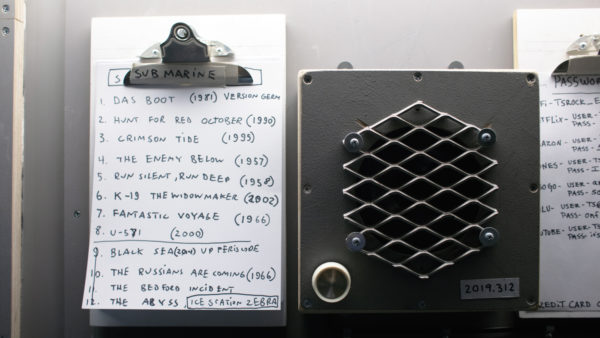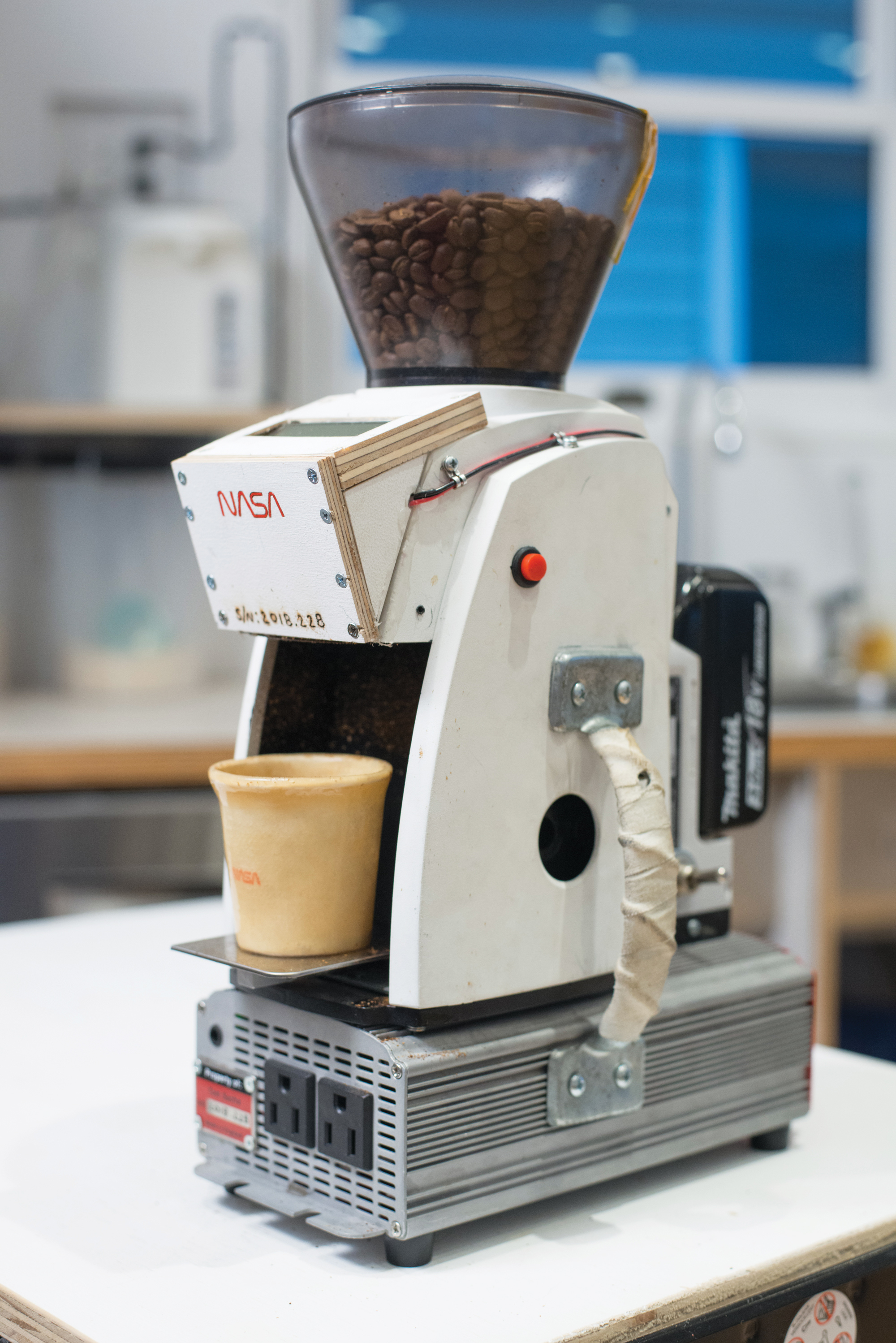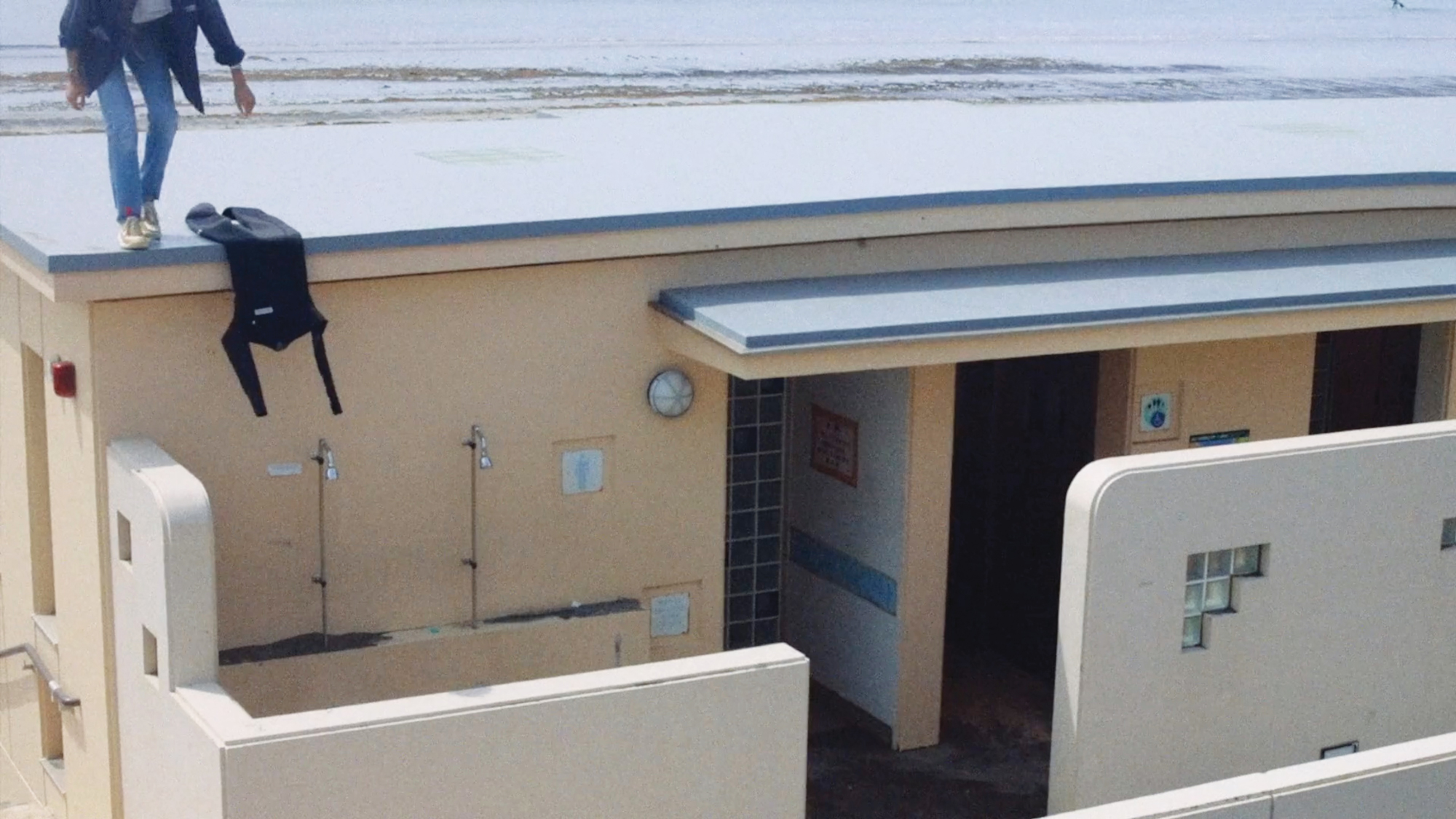“STANLEY KUBRICK IS DEAD” reads an etching in Tom Sachs’s familiar childlike script on a measuring tape mounted to a wall at the artist’s oceanside house in New York’s Rockaway Beach. This is secret code, scrutable to sharp-eyed Sachs initiates, as Kubrick, the storied movie director, died in 1999, the same year that Sachs—known for his bricolage sculptures and works in other mediums that play with DIY aesthetics—met the man he would collaborate with on more than 50 films of his own: Van Neistat.
“He was an ultimate do-it-yourselfer,” Sachs said of Kubrick (with whom he also happens to share a birthday). The 53-year-old sculptor was sitting cross-legged in his bedroom upstairs from where Neistat worked on Ritual, a short film—due out in 2020—set in Sachs’s surf house and devoted to the ceremonies and rites of surfing culture across the globe.
Sachs and Neistat have worked on movies of disparate kinds, but Ritual stands apart as a culmination of their shared pursuit of surf-borne pleasures and Sachs’s singular dedication to sculptural history and lore. The beach house that serves as its setting is a sort of Tom Sachs sculpture—an abode-as-artwork in the tradition of Kurt Schwitters’s Merzbau. The exterior is tiled with corrugated steel slats, fishing nets hang over the front from an observation deck, and the porch floorboards are made from old blue New York Department of Transportation barricades. Inside, storage places for nearly everything are labeled in Sachs’s signature scrawl: “spoons,” “paper towels,” “mugs,” “anal barbell” (the nature of that last one was unclear). A wall full of favored sustenance—cans of Heinz Baked Beans—bears teal labels that match the color of a Makita drill mounted over the kitchen sink.
The house is as much an experience as a residence. In the guest quarters, bunk beds are arranged under a womb-like red light to give the effect of being in a submarine, and recordings of whale song play—with a knob for volume control next to a list of recommended amphibious-warfare-related movies (Hunt for Red October, Das Boot) to watch on the TV. In the bathroom, instructions for how to flush a toilet are mounted to the wall, in a scroll-like fashion reminiscent of the opening credits to Star Wars. Outside, a gate bears a sign reading “All ye who enter must washeth thy feet else thy shall perish 666” beneath a bright-red pentagram. Beyond that, more than a dozen surfboards stand at attention.
“This house is in service to surfing,” Neistat, 44, explained. “The rituals around surfing are more interesting than the actual surfing.”

In October, Sachs and Neistat’s How to Learn How to Surf—which opens with the admission that no one in the movie is particularly good at the maritime pursuit—won “Best Surfing Short” at the Paris Surf & Skateboard Film Festival. Central to it is a consideration of what it means to be at peace with a certain lack of success.
“There’s a tremendous amount of failure,” Sachs said of surfing, a sport notorious for its steep learning curve. “But still, you go for the goal, go for the home run, try and make that cut right. Do things safe, clean up after yourself, show up on time. You’re going to be late—it happens. You just accept it and move on. That’s the goal of these movies: to provide a context in which we can simultaneously have excellence and accept our failures and not let it ruin our lives.”
Suitably, Sachs’s beach house contains a lot of purposeful imperfection. Seams are on proud display, lettering is crossed out and rewritten, the artist’s two-year-old son’s shoes (miniature versions of a line that Sachs designed for Nike) lie scattered across the entryway. “In a sculpture, you’ll always see a pencil mark, a glue drip, a weld, or whatever—because stuff happened there. It’s the same with the house: we want it to be real,” Sachs said.
Imperfection plays a similar role in Sachs’s films, emphatically low-fi productions in which iPhone shots have been known to appear in the final cut. As Sachs put it, over the course of their filmography, he and Neistat created “a language of moviemaking that was the same as the sculptures in that the movies are built—they always show the process of their making.”
Sachs met Neistat (brother and former collaborator of the famous YouTube video star Casey Neistat) through a happy accident, when the latter stopped on the street outside Sachs’s studio in downtown Manhattan to test a camera rig he had crafted for his bicycle. Sachs expressed curiosity about the contraption, and the rest is history.
Neistat started out as a fabricator in Sachs’s studio, where every gesture and every object created answers to the strict language of Sachs’s rhetoric and rules. With the movies, though, Sachs surrendered some of that control to Neistat, whose vision brings with it a reverence for straightforward instruction as well as an appreciation of absurdist kitsch.

On the set of Ritual on a rainy day in October, Gray Sorrenti—the star of the film and daughter of famed fashion photographer Mario Sorrenti—was using an espresso machine adorned with hand-drawn NASA lettering (and, as it happened, sitting next to a 14-inch dildo) to instruct viewers how to make the perfect cup of coffee. Many films by Sachs and Neistat are meant to serve as training manuals, covering tasks as simple as “how to sweep” or as ambitious as building interconnecting parts of a ramshackle enterprise for travel to Mars; Sachs put this latter project into action at the Park Avenue Armory in New York in 2012 and then, three years later, in the feature-length film A Space Program. “I’m very overwhelmed with the number of systems in my life,” he said.
Sachs’s best-known film, Ten Bullets (2010), epitomizes his practice in the form of a 20-minute meditation on the dogma behind what it means, physically and psychologically, to work in his studio, which has long been mythologized by his fans. When he hires new assistants and studio hands, Sachs has them watch Ten Bullets or Color (2011) for a kind of human-resources orientation featuring lessons like “In the interest of balance, the studio maintains a work hard, play hard policy” and “There is no place for the color purple in the studio.”
“Ten Bullets is like the Ten Commandments,” Sachs said of a film that—like many others in his oeuvre—transpires through a sort of voice-of-God narration and a filmic approach that is simultaneously playful and austere. “No one can live up to that high [a] standard—no one can do all of them. But it’s a compass.” Sachs’s ultimate goal is for anybody he works with to move out and make art or whatever else on their own terms. “But while you’re with us, working at the studio full-time or just for the minutes it takes to watch a movie,” he said, “we want it to be an enriching experience.”
There’s a certain Zen approach that Sachs wants his initiates to follow, and aspects of that figure in an interest in rituals that found expression in Tea Ceremony, an elaborate installation he first presented at the Noguchi Museum in Queens, New York, in 2016. In a setting that once served as a live/work space for the storied sculptor Isamu Noguchi, Sachs created self-styled buildings and accoutrements for traditional Japanese tea ceremonies accentuated with hyper-American fare such as Oreo cookies and Ritz crackers.

The idea for Ritual presented itself in the spring of 2019, when Neistat and Sachs, on a surfing trip in Japan, noticed the precise manner in which surfers in Kamakura hung their wetsuits up to dry on what Sachs described—with gusto—as a perfectly fabricated hook. “Originally, we wanted to do it about hooks, just hooks—a whole thing about hooks,” he said of the initial idea for cinematic subject matter. “But then we got carried away with all these other things we saw the surfers do.”
“It connected so well to Tea Ceremony,” Neistat said, “because Tea Ceremony is almost entirely about ritual.”
The rituals surveyed in the new film range from maintaining surf gear and getting sand off your body to both hosting guests and being a guest. “In our dream,” Sachs said, “it’s the movie that Airbnb hosts point to and say, ‘You can’t stay in my house until you watch this.’”
Other tips in the film involve practical matters like how to heat up a can of beans using only uncooked rice and how to put one leg into a wetsuit before the other to prevent having to shimmy too much. “Some of this stuff might seem preposterous, like really obsessing about a cup of coffee or how to hook a wetsuit,” Sachs said. “But anything can be taken up all the way to the most extreme art. I just want to champion the values of hard work.”





Recent Comments